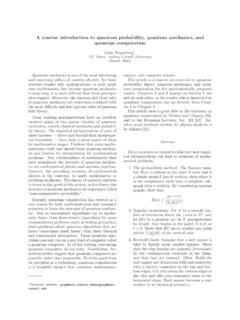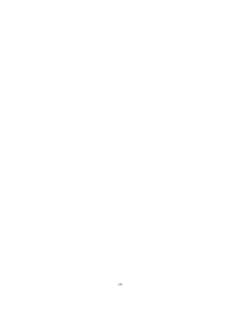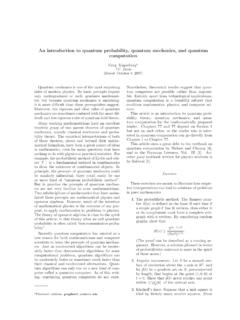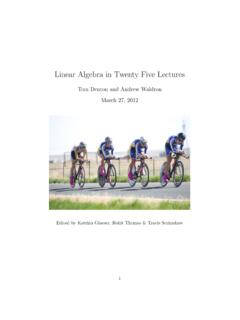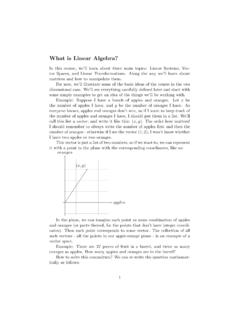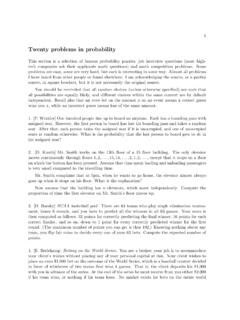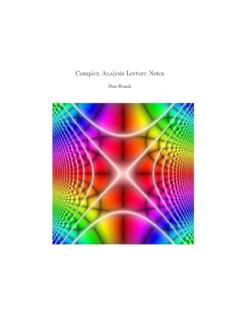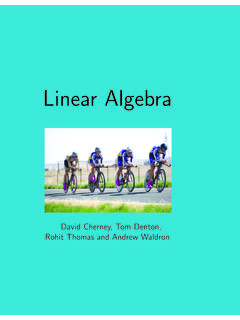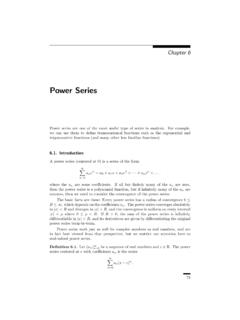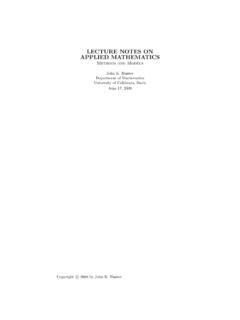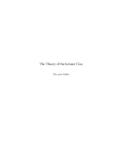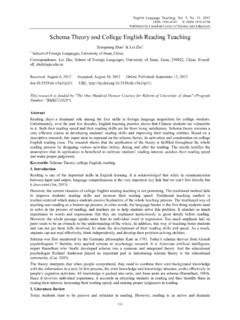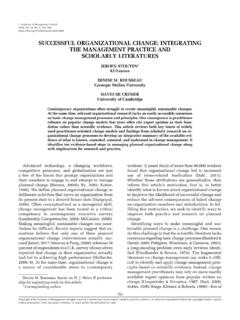Transcription of Measure Notes - University of California, Davis
1 8 CHAPTER 2 Lebesgue Measure onRnOur goal is to construct a notion of the volume, or Lebesgue Measure , of rathergeneral subsets ofRnthat reduces to the usual volume of elementary geometricalsets such as cubes or (Rn) denotes the collection of Lebesgue measurable sets and :L(Rn) [0, ]denotes Lebesgue Measure , then we wantL(Rn) to contain alln-dimensional rect-angles and (R) should be the usual volume of a rectangleR. Moreover, we want to be countably additive. That is, if{Ai L(Rn) :i N}is a countable collection of disjoint measurable sets, then their unionshould bemeasurable and [i=1Ai!= Xi=1 (Ai).The reason for requiring countable additivity is that finite additivity istoo weaka property to allow the justification of any limiting processes, while uncountableadditivity is too strong; for example, it would imply that if the measureof a setconsisting of a single point is zero, then the Measure of every subset ofRnwouldbe is not possible to define the Lebesgue Measure of all subsets ofRnin ageometrically reasonable way.]
2 Hausdorff (1914) showed that for any dimensionn 1, there is no countably additive Measure defined on all subsets ofRnthat isinvariant under isometries (translations and rotations) and assigns Measure one tothe unit cube. He further showed that ifn 3, there is no such finitely additivemeasure. This result is dramatized by the Banach-Tarski paradox : Banach andTarski (1924) showed that ifn 3, one can cut up a ball inRninto a finite numberof pieces and use isometries to reassemble the pieces into a ball of any desired a pea into the sun. The construction of these pieces requires theaxiom of (1923) also showed that ifn= 1 orn= 2 there arefinitely additive, isometrically invariant extensions of Lebesgue Measure onRnthatare defined on all subsets ofRn, but these extensions are not countably a detailed discussion of the Banach-Tarski paradox and related issues, see [10].
3 The moral of these results is that some subsets ofRnare too irregular to definetheir Lebesgue Measure in a way that preserves countable additivity (or even finiteadditivity inn 3 dimensions) together with the invariance of the Measure under1 Solovay (1970) proved that one has to use the axiom of choice to obtain non-Lebesguemeasurable LEBESGUE Measure ONRnisometries. We will show, however, that such a Measure can be defined on a -algebraL(Rn) of Lebesgue measurable sets which is large enough to include all setof practical importance in analysis. Moreover, as we will see, it is possible to definean isometrically-invariant, countablysub-additive outer Measure on all subsets are many ways to construct Lebesgue Measure , all of whichlead to thesame result.
4 We will follow an approach due to Carath eodory, whichgeneralizesto other measures: We first construct an outer Measure on all subsets ofRnbyapproximating them from the outside by countable unions of rectangles; we thenrestrict this outer Measure to a -algebra of measurable subsets on which it is count-ably additive. This approach is somewhat asymmetrical in that we approximatesets (and their complements) from the outside by elementary sets, but we do notapproximate them directly from the [5], Stein and Shakarchi [8], and Wheeler and Zygmund [11] give detailedintroductions to Lebesgue Measure onRn. Cohn [2] gives a similar development tothe one here, and Evans and Gariepy [3] discuss more advanced Lebesgue outer measureWe use rectangles as our elementary sets, defined as , closed rectangle with sides oriented parallelto the coordinate axes, or rectangle for short, is a subsetR Rnof the formR= [a1, b1] [a2, b2] [an, bn]where < ai bi< fori= 1.
5 , n. The volume (R) ofRis (R) = (b1 a1)(b2 a2)..(bn an).Ifn= 1 orn= 2, the volume of a rectangle is its length or area, also consider the empty set to be a rectangle with ( ) = 0. We denote thecollection of alln-dimensional rectangles byR(Rn), orRwhennis understood,and thenR7 (R) defines a map :R(Rn) [0, ).The use of this particular class of elementary sets is for convenience. We couldequally well use open or half-open rectangles, cubes, balls, or other suitable ele-mentary sets; the result would be the outer Lebesgue Measure (E) of a subsetE Rn, orouter Measure for short, is( ) (E) = inf( Xi=1 (Ri) :E S i=1Ri,Ri R(Rn))where the infimum is taken over all countable collections of rectangles whose unioncontainsE.]
6 The map :P(Rn) [0, ], :E7 (E)is called outer Lebesgue LEBESGUE OUTER MEASURE11In this definition, a sumP i=1 (Ri) and (E) may take the value . We donot require that the rectanglesRiare disjoint, so the same volume may contributeto multiple terms in the sum on the right-hand side of ( ); this does not affectthe value of the [0,1] be the set of rational numbers between 0and 1. ThenEhas outer Measure zero. To prove this, let{qi:i N}be anenumeration of the points inE. Given >0, letRibe an interval of length /2iwhich containsqi. ThenE S i=1 (Ri) so0 (E) Xi=1 (Ri) = .Hence (E) = 0 since >0 is arbitrary. The same argument shows that anycountable set has outer Measure zero.
7 Note that if we coverEby afinitecollectionof intervals, then the union of the intervals would have to contain [0,1] sinceEisdense in [0,1] so their lengths sum to at least previous example illustrates why we need to use countably infinitecollec-tions of rectangles, not just finite collections, to define the countable -trick used in the example appears in various forms throughout , we prove that is an outer Measure in the sense of Definition outer Measure has the following properties.(a) ( ) = 0;(b) ifE F, then (E) (F);(c) if{Ei Rn:i N}is a countable collection of subsets ofRn, then [i=1Ei! Xi=1 (Ei). follows immediately from Definition that ( ) = 0, since everycollection of rectangles covers , and that (E) (F) ifE Fsince any main property to prove is the countable subadditivity of.]
8 If (Ei) = for somei N, there is nothing to prove, so we may assume that (Ei) is finitefor everyi N. If >0, there is a countable covering{Rij:j N}ofEibyrectanglesRijsuch that Xj=1 (Rij) (Ei) + 2i,Ei [j= {Rij:i, j N}is a countable covering ofE= [i=1Ei2 The use of finitely many intervals leads to the notion of the Jordan content of a set, intro-duced by Peano (1887) and Jordan (1892), which is closely related to the Riemann integral; Borel(1898) and Lebesgue (1902) generalized Jordan s approach to allow for countably many intervals,leading to Lebesgue Measure and the Lebesgue LEBESGUE Measure ONRnand therefore (E) Xi,j=1 (Rij) Xi=1n (Ei) + 2io= Xi=1 (Ei) +.]]
9 Since >0 is arbitrary, it follows that (E) Xi=1 (Ei)which proves the result. Outer Measure of rectanglesIn this section, we prove the geometrically obvious, but not entirelytrivial, factthat the outer Measure of a rectangle is equal to its volume. The main point is toshow that the volumes of a countable collection of rectangles that cover a rectangleRcannot sum to less than the volume begin with some combinatorial facts about finite covers of rectangles [8].We denote the interior of a rectangleRbyR , and we say that rectanglesR,Sare almost disjoint ifR S = , meaning that they intersect at most along theirboundaries. The proofs of the following results are cumbersome towrite out indetail (it s easier to draw a picture) but we briefly explain the thatR=I1 I2 Inis ann-dimensional rectangle where each closed, bounded intervalIi Ris analmost disjoint union of closed, bounded intervals{Ii,j R:j= 1.}
10 , Ni},Ii=Ni[j=1Ii, the rectangles( ) ,j1 I2,j2 In, (R) =N1Xj1=1 NnXjn=1 ( ). the length of an intervalIby|I|, using the fact that|Ii|=NiXj=1|Ii,j|,3As a partial justification of the need to prove this fact, notethat it would not be true if weallowed uncountable covers, since we could cover any rectangle by an uncountable collection ofpoints all of whose volumes are OUTER Measure OF RECTANGLES13and expanding the resulting product, we get that (R) =|I1||I2|..|In|= N1Xj1=1|I1,j1| N2Xj2=1|I2,j2| .. NnXjn=1|In,jn| =N1Xj1=1N2Xj2=1 NnXjn=1|I1,j1||I2,j2|..|In,jn|=N1Xj1=1N2 Xj2=1 NnXjn=1 ( ). a rectangleRis an almost disjoint, finite union of rect-angles{R1, R2.]
